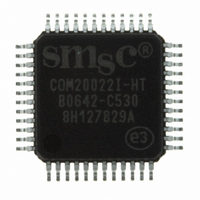COM20022I-HT SMSC, COM20022I-HT Datasheet - Page 55

COM20022I-HT
Manufacturer Part Number
COM20022I-HT
Description
IC CTRLR ARCNET 2KX8 RAM 48-TQFP
Manufacturer
SMSC
Series
ARCNETr
Datasheet
1.COM20022I3V-HT.pdf
(82 pages)
Specifications of COM20022I-HT
Controller Type
ARCNET Controller
Interface
Differential
Voltage - Supply
4.5 V ~ 5.5 V
Current - Supply
65mA
Operating Temperature
-40°C ~ 85°C
Mounting Type
Surface Mount
Package / Case
48-TQFP, 48-VQFP
Lead Free Status / RoHS Status
Lead free / RoHS Compliant
Other names
638-1003
Available stocks
Company
Part Number
Manufacturer
Quantity
Price
Company:
Part Number:
COM20022I-HT
Manufacturer:
Standard
Quantity:
5 410
Company:
Part Number:
COM20022I-HT
Manufacturer:
SMSC
Quantity:
455
Company:
Part Number:
COM20022I-HT
Manufacturer:
Microchip Technology
Quantity:
10 000
10 Mbps ARCNET (ANSI 878.1) Controller with 2Kx8 On-Chip RAM
Datasheet
6.10.2 Abnormal Results:
6.11
SMSC COM20022I
RCVACT=1, TOKEN=0, TXEN=X: The node sees receive activity, but does not see the token. Either no
other nodes exist on the network, some type of data corruption exists, the media driver is malfunctioning,
the topology is set up incorrectly, there is noise on the network, or a reconfiguration is occurring.
RCVACT=0, TOKEN=0, TXEN=1: No receive activity is seen and the basic transmit function is enabled.
The transmitter and/or receiver are not functioning properly.
RCVACT=0, TOKEN=0, TXEN=0: No receive activity and basic transmit function disabled. This node is
not connected to the network.
The Excessive NAK (EXCNAK) bit is used to replace a timeout function traditionally implemented in
software. This function is necessary to limit the number of times a sender issues a FBE to a node with no
available buffer. When the destination node replies to 128 FBEs with 128 NAKs or 4 FBEs with 4 NAKs,
the EXCNAK bit of the sender is set, generating an interrupt. At this point the software may abandon the
transmission via the "Disable Transmitter" command. This sets the TA bit to logic "1" when the node next
receives the token, to allow a different transmission to occur. The timeout value for the EXNACK bit (128
or 4) is determined by the FOUR-NAKS bit on the Setup1 Register.
The user may choose to wait for more NAK's before disabling the transmitter by taking advantage of the
wraparound counter of the EXCNAK bit. When the EXCNAK bit goes high, indicating 128 or 4 NAKs, the
"POR Clear Flags" command may be issued to reset the bit so that it will go high again after another
count of 128 or 4. The software may count the number of times the EXCNAK bit goes high, and once the
final count is reached, the "Disable Transmitter" command may be issued.
The New Next ID bit permits the software to detect the withdrawal or addition of nodes to the network.
The Tentative ID bit allows the user to build a network map of those nodes existing on the network. This
feature is useful because it minimizes the need for human intervention. When a value placed in the
Tentative ID Register matches the Node ID of another node on the network, the TENTID bit is set, telling
the software that this NODE ID already exists on the network. The software should periodically place
values in the Tentative ID Register and monitor the New Next ID bit to maintain an updated network map.
Oscillator
The COM20022I contains circuitry which, in conjunction with an external parallel resonant crystal or TTL
clock, forms an oscillator.
If an external crystal is used, two capacitors are needed (one from each leg of the crystal to ground). No
external resistor is required, since the COM20022I contains an internal resistor. The crystal must have an
accuracy of 0.020% or better. The oscillation frequency range is from 10 MHz to 20 MHz.
The crystal must have an accuracy of 0.010% or better when the internal clock multiplier is turned on. The
oscillation frequency must be 20MHz when the internal clock multiplier is turned on.
The XTAL2 side of the crystal may be loaded with a single 74HC-type buffer in order to generate a clock
for other devices.
The user may attach an external TTL clock, rather than a crystal, to the XTAL1 signal. In this case, a
390 Ω pull-up resistor is required on XTAL1, while XTAL2 should be left unconnected.
DATASHEET
Page 55
Revision 09-27-07













